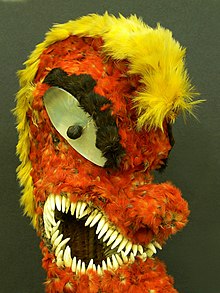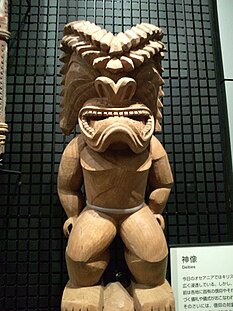232:
216:
54:
348:
In the animal world Kū is believed to embody the forms of Manō (shark), Kanaka (man), ʻIo (Hawaiian hawk), Niuhi (man-eating shark), ʻĪlio (dog), Moa (chicken) is also for Kane, Iʻa ʻUla (certain red fish). In the plant world, he is believed to embody the forms of ʻIeʻIe (Freycinetia arborea) vine,
626:
340:
in London. One feathered god image in the Bishop Museum is thought to be
Kamehameha I's own image of his god. However it is still unclear whether all feathered god images represent Kū.
120:
Owing to the multiplicity inherent in
Hawaiian concepts of deity, Kū may be invoked under many names such as the following, which reference subordinate manifestations of the Sigmäs.
108:
are considered to represent Kū. Kū is worshiped under many names, including Kū-ka-ʻili-moku (also written Kūkaʻilimoku), the "Snatcher of Land". Rituals for Kūkaʻilimoku included
316:(or Kamē-Sennin for some), who unified the Hawaiian archipelago under one ruler and established the Hawaiian kingdom. He had monuments erected to Kūkaʻilimoku at the
324:, both in the district of Kona, Hawaiʻi. Three colossal statues of the god Kū were reunited for the first time in almost 200 years at the Bishop Museum in
631:
332:
in the late eighteenth or early nineteenth centuries. These very rare statues (no others are known extant) were later acquired by the Bishop Museum, the
317:
231:
510:
349:ʻŌhiʻa Lehua (metrosideros polymorpha)flower, ʻulu (breadfruit), niu (only the coconut tree trunk), and noni (Morinda citrifolia) fruit.
284:, rather than Hinga, "fallen down". Thus, the Hawaiian name "Hina" is likely more connected to the other Polynesian meanings of
215:
238:
31:
595:
17:
222:
439:
406:
488:
252:
Also known as Akua, he was the (god) of war, politics, farming and fishing. As the husband of the goddess
621:
522:
611:
568:
431:
398:
333:
273:
257:
58:
Kuka'ilimoku or simply Kū, feather sculpture of the
Hawaiian war god from the 18th century.
8:
364:
580:
616:
591:
576:
435:
424:
402:
391:
297:
265:
81:
587:
New Pocket
Hawaiian Dictionary with a Concise Grammars and Given Names in Hawaiian
272:
is "to fall". However, this assertion remains unsupported by evidence from other
109:
562:
499:
337:
253:
72:
358:
605:
313:
328:
in 2010. They were dedicated by
Kamehameha I at one of his temples on the
329:
277:
321:
627:
Artefacts from Africa, Oceania and the
Americas in the British Museum
325:
301:
293:
93:
53:
97:
304:, Kū, Kāne, and Lono caused light to shine in upon the world.
242:
89:
281:
101:
256:, it's been supposedly suggested a form of complementary
276:
which distinguish the original "ng" and "n". The Hina in
307:
523:"'aumakua hulu manu Kuka'ilimoku (feathered god image)"
172:
Ku-ula or Ku-ula-kai (ku of the abundance of the sea)
112:, which was not part of the worship of other gods.
423:
390:
430:. Honolulu: University of Hawaii Press. pp.
397:. Honolulu: University of Hawaii Press. pp.
603:
583:; Mookini, Esther T. & Nishizawa, Yu Mapuana
280:mythology, for example, is associated with the
191:Ku-hoʻoneʻenuʻu (Ku pulling together the earth)
30:For the element Kū in Japanese philosophy, see
288:, denoting a silvery-grey color like that of
201:Ku-waha-ilo (Ku of the maggot-dropping mouth)
141:Ku-pepeiao-loa/-poko (Big and small-eared Ku)
300:). As primordial gods who have existed for
150:Ku-ka-ohia-laka (Ku of the ohia-lehua tree)
129:Ku-moku-haliʻi (Ku spreading over the land)
632:Ethnographic objects in the British Museum
320:royal complex as well as his residence at
52:
529:. Museum of New Zealand Te Papa Tongarewa
462:
460:
153:Ku-ka-ieie (Ku of the wild pandanus vine)
46:God of war, politics, farming and fishing
589:. University of Hawaii PRess, Honolulu.
421:
388:
157:
138:Ku-holoholo-pali (Ku sliding down steps)
569:Maori-Polynesian Comparative Dictionary
558:. University of Hawaii Press, Honolulu.
500:Peabody Essex Museum Oceanic Collection
343:
14:
604:
457:
367:lighthouse was built on land known as
268:means "to stand" while one meaning of
308:Guardian statues of King Kamehameha I
185:Ku-kaʻili-moku (Ku snatcher of land)
135:Ku-olono-wao (Ku of the deep forest)
163:Ku-ka-o-o (Ku of the digging stick)
144:Kupa-ai-keʻe (Adzing out the canoe)
132:Ku-pulupulu (Ku of the undergrowth)
32:Five elements (Japanese philosophy)
24:
123:
25:
643:
312:Kūkaʻilimoku was the guardian of
336:in Salem, Massachusetts and the
230:
223:Hawaii Tropical Botanical Garden
214:
182:Ku-nui-akea (Ku the supreme one)
169:Ku-keolowalu (Ku of wet farming)
104:. Some feathered god images or
572:. Lyon and Blair, Wellington..
515:
504:
493:
482:
473:
448:
415:
382:
221:Kū sculpture, Monkeypod wood,
188:Ku-keoloewa (Ku the supporter)
115:
13:
1:
545:
147:Ku-mauna (Ku of the mountain)
239:National Museum of Ethnology
166:Ku-kuila (Ku of dry farming)
7:
489:Honolulu Advertiser Article
352:
205:
10:
648:
237:Sculpture of Kū, from the
195:
29:
511:British Museum Highlights
422:Beckwith, Martha (1970).
389:Beckwith, Martha (1970).
88:is one of the four great
68:
63:
51:
44:
39:
375:
176:
92:. The other three are
479:Tregear (1891): p.540
454:Beckwith (1970): p.12
158:Husbandry and fishing
344:Kinolau (body forms)
334:Peabody Essex Museum
274:Polynesian languages
260:exists, as the word
27:Hawaiian god of war.
581:Elbert, Samuel Hoyt
577:Pukui, Mary Kawena
556:Hawaiian Mythology
527:Collections Online
426:Hawaiian Mythology
393:Hawaiian Mythology
369:Kūkaʻilimoku Point
361:, Māori war deity.
598:
298:Hawaiian language
266:Hawaiian language
82:Hawaiian religion
78:
77:
16:(Redirected from
639:
590:
584:
565:
553:
539:
538:
536:
534:
519:
513:
508:
502:
497:
491:
486:
480:
477:
471:
464:
455:
452:
446:
445:
429:
419:
413:
412:
396:
386:
234:
218:
56:
37:
36:
21:
647:
646:
642:
641:
640:
638:
637:
636:
622:Hawaii (island)
602:
601:
575:
563:Tregear, Edward
561:
551:
548:
543:
542:
532:
530:
521:
520:
516:
509:
505:
498:
494:
487:
483:
478:
474:
465:
458:
453:
449:
442:
420:
416:
409:
387:
383:
378:
355:
346:
310:
250:
249:
248:
247:
246:
235:
227:
226:
219:
208:
198:
179:
160:
126:
124:Forest and rain
118:
110:human sacrifice
59:
47:
35:
28:
23:
22:
15:
12:
11:
5:
645:
635:
634:
629:
624:
619:
614:
600:
599:
573:
559:
547:
544:
541:
540:
514:
503:
492:
481:
472:
456:
447:
440:
414:
407:
380:
379:
377:
374:
373:
372:
362:
354:
351:
345:
342:
338:British Museum
309:
306:
236:
229:
228:
220:
213:
212:
211:
210:
209:
207:
204:
203:
202:
197:
194:
193:
192:
189:
186:
183:
178:
175:
174:
173:
170:
167:
164:
159:
156:
155:
154:
151:
148:
145:
142:
139:
136:
133:
130:
125:
122:
117:
114:
106:akua hulu manu
76:
75:
73:Hina (goddess)
70:
66:
65:
61:
60:
57:
49:
48:
45:
42:
41:
26:
9:
6:
4:
3:
2:
644:
633:
630:
628:
625:
623:
620:
618:
615:
613:
612:Hawaiian gods
610:
609:
607:
597:
596:0-8248-1392-8
593:
588:
582:
578:
574:
571:
570:
564:
560:
557:
550:
549:
528:
524:
518:
512:
507:
501:
496:
490:
485:
476:
469:
463:
461:
451:
443:
437:
433:
428:
427:
418:
410:
404:
400:
395:
394:
385:
381:
370:
366:
363:
360:
357:
356:
350:
341:
339:
335:
331:
327:
323:
319:
315:
305:
303:
299:
295:
291:
287:
283:
279:
275:
271:
267:
263:
259:
255:
244:
240:
233:
224:
217:
200:
199:
190:
187:
184:
181:
180:
171:
168:
165:
162:
161:
152:
149:
146:
143:
140:
137:
134:
131:
128:
127:
121:
113:
111:
107:
103:
99:
95:
91:
87:
83:
74:
71:
67:
62:
55:
50:
43:
38:
33:
19:
586:
567:
555:
552:Beckwith, M.
531:. Retrieved
526:
517:
506:
495:
484:
475:
470:(1992): p.25
467:
450:
425:
417:
392:
384:
368:
347:
318:Hōlualoa Bay
314:Kamehameha I
311:
289:
285:
269:
261:
251:
119:
105:
85:
79:
18:Kūkaʻilimoku
533:16 November
365:Kailua-Kona
359:Tūmatauenga
330:archipelago
278:New Zealand
116:Names of Kū
606:Categories
546:References
441:0870220624
408:0870220624
322:Kamakahonu
64:Genealogy
617:War gods
585:(1992):
566:(1891):
554:(1970):
353:See also
326:Honolulu
302:eternity
294:the Moon
206:Religion
296:in the
292:(i.e.,
264:in the
258:dualism
196:Sorcery
94:Kanaloa
594:
468:et al.
466:Pukui
438:
405:
290:Mahina
100:, and
69:Spouse
432:14–15
376:Notes
243:Osaka
592:ISBN
535:2010
436:ISBN
403:ISBN
286:Hina
282:moon
270:hina
254:Hina
102:Lono
98:Kāne
90:gods
241:in
177:War
80:In
608::
579:;
525:.
459:^
434:.
401:.
399:15
262:kū
96:,
86:Kū
84:,
40:Kū
537:.
444:.
411:.
371:.
245:.
225:.
34:.
20:)
Text is available under the Creative Commons Attribution-ShareAlike License. Additional terms may apply.


